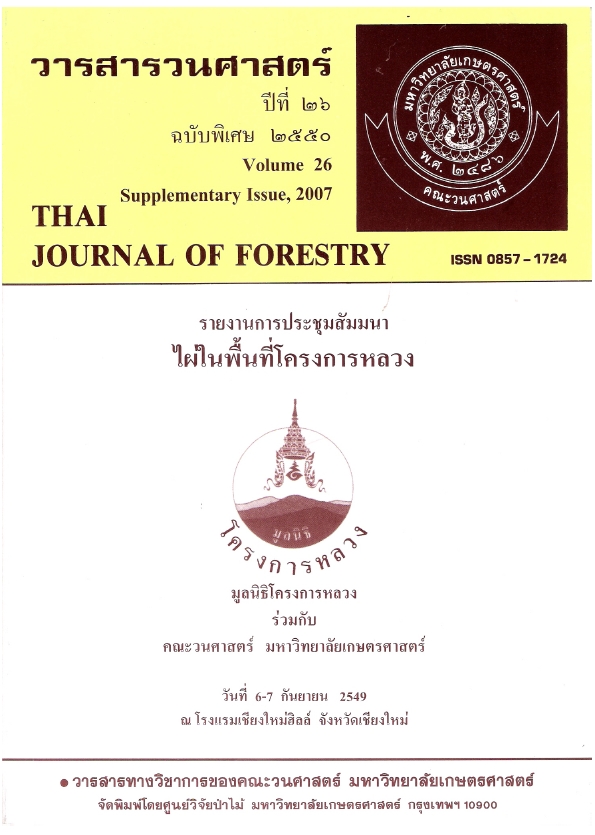การวิเคราะห์ปัจจัยที่มีผลต่อการพึ่งพิงทรัพยากรไม้ไผ่ และการปลูกไม้ไผ่ของครัวเรือนในพื้นที่โครงการหลวง
Main Article Content
บทคัดย่อ
ไม้ไผ่เป็นทรัพยากรป่าไม้ที่อยู่คู่กับการดำรงชีวิตของคนไทยทั้งในเมืองและชนบทมาเป็นเวลานาน ไม่ไผ่มีสภาพเสื่อมโทรมลงตามการลดลงของทรัพยากรป่าไม้ การศึกษาครั้งนี้มีวัตถุประสงค์เพื่อแสวงหาองค์ความรู้ที่เกี่ยวข้องกับสภาพเศรษฐกิจและสังคม สภาพการใช้ การพึ่งพิงทรัพยากรไม้ไผ่ รวมถึงความคิดเห็นเกี่ยวกับการปลูกไผ่หวานบนพื้นที่สูงและวิเคราะห์ปัจจัยที่มีผลกระทบต่อการพึ่งพิงทรัพยากรไม้ไผ่ของครัวเรือนในเขตพื้นที่ โครงการหลวง โดยใช้ข้อมูลปฐมภูมิจากการสำรวจที่ใช้แบบสอบถามกับกลุ่มตัวอย่างของครัวเรือนในเขตพื้นที่รับผิดชอบของมูลนิธิโครงการหลวงในเขตจังหวัดเชียงใหม่ จำนวน 236 ครัวเรือน ปีการเพาะปลูก 2546/47 และในเขตจังหวัดเชียงราย แม่ฮ่องสอน พะเยา และลำพูน จำนวน 226 ครัวเรือน ปีการเพาะปลูก 2547/48 รวมตัวอย่าง 462 ครัวเรือน ผลการศึกษาสภาพทั่วไปของครัวเรือน พบว่า ครัวเรือนมีสมาชิกเฉลี่ย 5 คน มีชาติพันธุ์หลักเป็น กะเหรี่ยง มั้ง ลัวะ และมูเซอ ครัวเรือนมีขนาดพื้นที่ทำกินประมาณ 17.08 ไร่ เป็นเจ้าของเองหรือได้สิทธิ์ทำกินโดยไม่เสียค่าใช้ง่ายเป็นส่วนใหญ่ โดยเป็นพื้นที่ที่มูลนิธิ โครงการหลวงจัดสรรให้ถึงร้อยละ 59.29 ครัวเรือน ส่วนใหญ่ประกอบอาชีพเกษตรกรรมเป็นอาชีพหลัก มีรายได้ครัวเรือนเฉลี่ย 111,681.86 บาทต่อปี มีค่าใช้จ่ายรวมเฉลี่ย 78,362.53 บาทต่อปี คิดเป็นรายได้สุทธิเฉลี่ย 33,319.33 บาทต่อครัวเรือนต่อปี แต่ก็มีหนี้สินเฉลี่ย 32,484. 97 บาทต่อครัวเรือน โดยพบว่าเกือบครึ่งหนึ่งเป็นครัวเรือนที่มีรายได้พอใช้จ่ายแต่ไม่มีเงินออม ทั้งนี้ครัวเรือนตัวอย่างส่วนใหญ่ระบุว่าราคาพืชผลตกต่ำเป็นปัญหาที่รุนแรง และต้องการความช่วยเหลือจากภาครัฐในเรื่องการพัฒนาสาธารณูปโภคในชุมชน ผลการประเมินการพึ่งพิงทรัพยากรป่าไม้ พบว่า ครัวเรือนตัวอย่างร้อยละ 73.59 มีการเก็บหาของป่ามาใช้ประโยชน์ และมีร้อยละ 34.41 ที่ซื้อของป่ามาใช้ประโยชน์ คิดเป็นมูลค่าที่ซื้อเฉลี่ย 725 บาทต่อครัวเรือนต่อปี เมื่อพิจารณาถึงครัวเรือนที่พึ่งพิงทรัพยากรไม้ไผ่ พบว่าร้อยละ 58.66 มีการเก็บหาหน่อไม้ และร้อยละ 37.88 มีการเก็บหาไม้ไผ่ โดยนำมาใช้ในการก่อสร้างหรือซ่อมแซมบ้านหรือโรงเรือนมากที่สุด รองลงมานำมาใช้ทำค้างหรือโครงในการปลูกพืช และทำเครื่องจักสาน มีครัวเรือนตัวอย่างถึงร้อยละ 50 ที่ทำการปลูกไม้ไผ่ในบริเวณบ้านและที่หัวไร่ปลายนา โดยพันธุ์ไม้ไผ่ที่ปลูกได้มาจากเพื่อนข้านเป็นส่วนใหญ่ ผลการศึกยาแสดงว่ามีเพียงร้อยละ 36.36 ที่ทราบเกี่ยวกับการทดลองปลูกไผ่หวานในพื้นที่โครงการหลวง และมีเพียงร้อยละ 10. 17 เท่านั้นที่ได้รับพันธุ์ไผ่หวานมาปลูกแล้ว นอกจากนี้ยังพบว่ามีครัวเรือนที่ไม่มีความรู้เกี่ยวกับการปลูกไผ่หวานบนพื้นที่สูงถึงร้อยละ 55.63 และมีเพียงร้อยละ 10.17 ที่มีความรู้และเคยเข้ารับการฝึกอบรม ทั้งนี้เงื่อนไขการมีตลาดรองรับและผลตอบแทนที่คุ้มทุนเป็นเรื่องที่สำคัญที่สุดที่ครัวเรือนตัวอย่างจะตัดสินใจเข้าร่วมโครงการปลูกไผ่หวาน ในการศึกษาความสัมพันธ์ระหว่างปัจจัยทางเศรษฐกิจและสังคมกับการพึ่งพิงทรัพยากรไม้ไผ่จากป้าธรรมชาติของครัวเรือนในเขตพื้นที่ โครงการหลวง พบว่า ในกลุ่มเขตพื้นที่ โครงการหลวงจังหวัดเชียงใหม่ มีปัจจัยที่มีผลต่อการพึ่งพิงทรัพยากรไม้ไผ่ ได้แก่ อาชีพหลัก ผ่าพันธุ์ รายได้รวม เวลาในการเดินทางไปก็บหาทรัพยากรไม้ไผ่ และอุปสรรคในการเก็บหาทรัพยากรไม้ไผ่ ส่วนในกลุ่มเขตพื้นที่ โครงการหลวงจังหวัดเชียงราย แม่ฮ่องสอน พะเยา และลำพูน พบว่า ปัจจัยที่มีผลต่อการพึ่งพิงทรัพยากรไม้ไผ่ ได้แก่ เผ่าพันธุ์ รายได้รวม หนี้สินระยะเวลาในการเดินทางไปเก็บหาทรัพยากรไม้ไผ่ อุปสรรคในการเก็บหาทรัพยากรไม้ไผ่ และการปลูกไม้ไผ่ไว้ในครัวเรือน
คำสำคัญ: ทรัพยากรไผ่ พื้นที่สูง เศรษฐสังคม มูลนิธิโครงการหลวง
Downloads
Article Details

อนุญาตภายใต้เงื่อนไข Creative Commons Attribution-NonCommercial-NoDerivatives 4.0 International License.
ข้าพเจ้าและผู้เขียนร่วม (ถ้ามี) ขอรับรองว่า ต้นฉบับที่เสนอมานี้ยังไม่เคยได้รับการตีพิมพ์และไม่ได้อยู่ในระหว่างกระบวนการพิจารณาตีพิมพ์ลงในวารสารหรือสิ่งตีพิมพ์อื่นใด ข้าพเจ้าและผู้เขียนร่วม (ถ้ามี) ยอมรับหลักเกณฑ์และเงื่อนไขการพิจารณาต้นฉบับ ทั้งยินยอมให้กองบรรณาธิการมีสิทธิ์พิจารณาและตรวจแก้ต้นฉบับได้ตามที่เห็นสมควร พร้อมนี้ขอมอบลิขสิทธิ์ผลงานที่ได้รับการตีพิมพ์ให้แก่วารสารวนศาสตร์ คณะวนศาสตร์ มหาวิทยาลัยเกษตรศาสตร์ กรณีมีการฟ้องร้องเรื่องการละเมิดลิขสิทธิ์เกี่ยวกับภาพ กราฟ ข้อความส่วนใดส่วนหนึ่ง หรือ ข้อคิดเห็นที่ปรากฏในผลงาน ให้เป็นความรับผิดชอบของข้าพเจ้าและผู้เขียนร่วม (ถ้ามี) แต่เพียงฝ่ายเดียว และหากข้าพเจ้าและผู้เขียนร่วม (ถ้ามี) ประสงค์ถอนบทความในระหว่างกระบวนการพิจารณาของทางวารสาร ข้าพเจ้าและผู้เขียนร่วม (ถ้ามี) ยินดีรับผิดชอบค่าใช้จ่ายทั้งหมดที่เกิดขึ้นในกระบวนการพิจารณาบทความนั้น”


